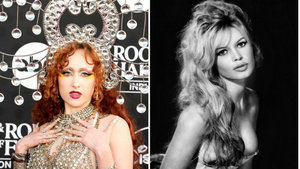Lisbeth Salander -- the queer female antiheroine and computer hacker from the Stieg Larsson novels -- is back on the big screen in The Girl in the Spider's Web.
Claire Foy, who recently won an Emmy for her role as young Queen Elizabeth II in Netflix's The Crown, is the latest actress to bring Salander to life; previous film adaptations starred Noomi Rapace, in a Swedish trilogy, and Rooney Mara, in 2011's U.S. release The Girl With the Dragon Tattoo.
Yet Foy's Salander returns at a pivotal moment in pop culture. The character, a survivor of rape, is known for imposing vigilante justice on men who inflict sexual assault and other violence on women, a storyline that has taken on new urgency in the midst of the #MeToo movement. A trailer for the film, in which Salander ties up an attacker and transfers his money to his victims, depicts the character as a literal avenging angel -- framed by a statue, with black wings rising from her shoulders as she dispenses justice.
And as Marvel films roll out a lineup of straight, predominantly male superheroes, Salander -- who has male and female lovers and can handle a gun and ride a motorcycle as well as she hacks the U.S. government -- is a breath of fresh air.
At a Tuesday press event at Sony Pictures Studios in Los Angeles, Foy discussed how Salander and her sexuality stand out from the typical heteronormative fare that usually fills mainstream cinemas.
"I think the thing that I love about her so much is her unwillingness to be identified in any particular way," Foy said of Salander, when asked by The Advocate about the meaning of having a big-budget film center on a queer female character. "She rejects any labeling, anything that society wants to put on her, anything that anyone else wants to put on her. She lives entirely as herself and therefore she will seek pleasure where she seeks pleasure, whether that's with a man or a woman or on her own."
Foy added that, as a character who rejects labels, Salander also does not judge others on their own identities. This is a quality that she admires. "I think you could do with more people who kind of are open to absolutely everything and therefore accept that in other people as well," Foy said.
The Spider's Web actress said that she and director Fede Alvarez agreed it was important that Salander's sexuality be portrayed as independent of her character and not become a queer "cliche" with any associative stereotypes. "Ultimately it's about the person and finding truth of that person," she said.
To this end, an idea for a queer sex scene in the film was nixed, said Foy, because "it didn't serve the character ... and you know, the last thing anyone would ever want to do is put on a random titillating thing in there if it doesn't serve a purpose of the story."
Alvarez (Evil Dead, Don't Breathe), who was also at the press event, said that one of the largest departures of this reboot of the Girl franchise is its point of view. "This is the first time that we dare to tell a story 100 percent about her," said Alvarez, meaning Salander. Previous films, he noted, rolled out through the lens of the male journalist Mikael Blomkvist, whereas Salander was a "unicorn" that remained on the periphery.
"She's like a feminist Batman," said Alvarez, who agreed that there is a "superhero" element to her character -- who indeed boasts a high-tech lair, a black costume, and a fickle relationship with a journalist.
However, unlike other unnamed films, where female superheroes are still expected to look "impeccable and pretty in tight clothes," Spider's Web took great care not to be "exploitational" of women, Alvarez promised. For one, this meant eschewing "tighter clothes and leather" for Foy's costumes that would have objectified the actress.
"Claire was the guardian of making sure that we didn't do anything that felt exploitation-y," said Alvarez, who revealed the pair even "had discussions about like how the camera will move." He recalled how Foy reminded him that he was a "white man, Fede. Don't forget," and to treat his filming of her and her body with respect.
These conversations forced Alvarez to constantly reconsider his perspective as a male director. "Am I making it too sexy right now?" he remembered thinking during production as he gazed at the camera. "No, maybe not. I should pull back."
Foy sees the recentering of Girl from Salander's viewpoint as an encouraging sign of the times -- particularly since her character, in addition to passing the Bechdel test, is about as far from a conventional female role as possible.
"Now you can trust in an audience loving a difficult character," Foy said. "She's not lovable. She's not polite. She's not pretty. She's not everything that you think a female protagonist is supposed to be, [like] soft. ... She's hard and ... she makes really terrible, terrible decisions and you [don't] know whether you can get behind a lot of them."
And as much as Girl resonates with the current #MeToo climate, Foy rejected the idea that Salander is a "poster girl" for the movement. The film "wasn't jumping on a bandwagon," she stressed. "The interest in Lisbeth has always been there, and everyone's always been deeply fascinated by her. And much like the #MeToo movement, that's not because it's timely or that it's kind of suddenly in the zeitgeist and it's newsworthy."
"It's always been there, is the reality," Foy said of the culture of sexual assault. "The difference is that people are now listening and talking about it openly as opposed to just ignoring it."
The Girl in the Spider's Web premieres November 9 in theaters. Watch the trailer below.




































































Charlie Kirk DID say stoning gay people was the 'perfect law' — and these other heinous quotes